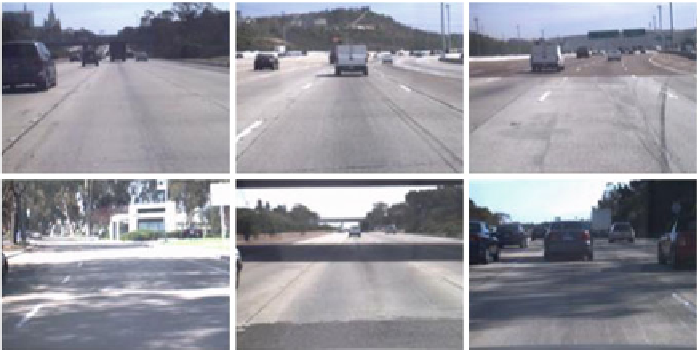Graphics Reference
In-Depth Information
Fig. 10.1
Challenging road scenes to detect lanes: different types of lane markings—dashed lanes
and circular reflectors, tar color changes, tire skid marks, shadows of trees, vehicles, infrastructure,
etc.
step includes algorithms such as RANSAC [
1
,
16
], Hough transform [
1
,
10
,
14
],
etc. Finally trackers like Kalman filters [
10
] or particle filters [
5
] are used to model
the tracking of lanes. This is inspired from the fact that there is a predictability of
the lane positions in every frame based on the information from past frames and the
knowledge of the vehicle dynamics.
The computing algorithms in these methods can be closely related to some aspects
of the human visual system's (HVS') perception of lanes. In [
10
,
16
], lane features
are extracted using steerable filters, which detect directional gradients. This can
be related to the HVS' perception of lanes as being directionally pointed toward the
vanishing point and having higher intensities than the background. Similar reasoning
is used to extract lane features using Gabor filter kernels in [
8
]. Another way that
the HVS uses is the changes in the gray level intensities of the lane markings. This
kind of perception is used in [
12
] to extract lanes where lanes are detected as straight
lines of constant width and having a specific range of gray level intensities. Though
this model works well for lanes in near-view, the straight model of the lanes may fail
to capture lanes in far-view of the ego-vehicle. However, the work presented in [
12
]
uses other modalities like stereo vision, GPS, etc., to model the digital map of the
ego-vehicle. A more general model using the same gray level perception property
is employed by Borkar et al. in [
1
], in which an adaptive thresholding method is
proposed to extract the brighter lanes from darker road surface. A temporal averaging
is also employed in [
1
], which averages the dashed lane markings over time, so that
a continuous line is seen in every frame instead of dashed lanes. This follows from
the HVS' perception that the lanes are actually straight lines but spatially sampled
along the road, which gives a dashed appearance. In addition to these methods based
on perception of visual properties of lanes, a learning-based approach is presented

